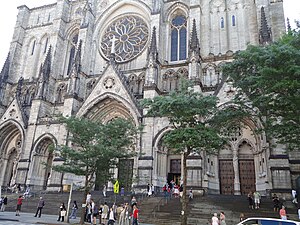It’s the end of the school year, and the first grade capped off our work with another research project, this time on Cathedral Church of St. John the Divine. The Cathedral School began as a choir school for the cathedral, and we remain deeply connected to it. Our premises occupy its close and the school still provides singers for the cathedral’s choir. St. John is an increasingly less hidden New York treasure; it’s the largest gothic cathedral in the world and an integral monument in the history of architecture, immigration and social activism in the city.
Growing throngs of tourists are beginning to appreciate “our” cathedral, but, understandably, kids who go to school in its shadow every day can grow a bit jaded. The cathedral is a much larger institution than our school, both physically and in its historic and social reach. However, our students sometimes seem to think of it as an extension of our school simply because spending time there is embedded in our routine. We venture into the cathedral for everything from our weekly chapel service to math projects. Often, our students don’t quite seem to understand why busloads of foreigners are milling around with cameras.
Hence, the class is collaboratively writing a guidebook for the cathedral, a project that long predates my arrival in first grade. We spent weeks touring the Cathedral, taking scrupulous notes on its history and architecture. For the students, the cathedral served as a treasure trove of hidden symbols and artwork, secret stairways and peculiar stories. Our exploration revealed the depth of mystery housed in this familiar space. The revelation of how little they really knew about the cathedral as well as the realization of how far the cathedral’s significance extends beyond our school was a humbling experience for my students. We began to see them staring ponderously at and asking questions about previously ignored corners of the building, examining its artwork and speculating about its construction.
Yet the project was also a celebration of our privileged relationship with the cathedral. Foregoing their frequent sense of entitlement, my students took the authentic brand of ownership qualified by deep knowledge and genuine appreciation. We’ve impressed upon them that the cathedral “belongs” to everyone, but the fact remains that we possess certain entitlements to the building that others do not. Our study conducted them towards an understanding of the origins and uniqueness of that privilege. Pursuing expert knowledge of the cathedral does a great deal to help my students situate their small community within our city’s history, architecture and religious heritage. Our study allows the cathedral to become an intermediary in my students’ long effort to orient themselves in the world.
Culminating the project with the composition of the guidebook — which the students used to take friends and family on a tour — directed the purpose of our study beyond our classroom. The work felt purposeful for the students. The guidebook was a means of sharing the benefits of our special connection to the cathedral, if only with those close to them. For my students in particular, who are fortunate enough to attend a highly effective independent school in New York City, awareness that privileges should be understood and their benefits shared with others may go a long way.
This project, which took quite a few weeks to complete, was a wonderful way to celebrate our community at the end of the year. As the kids in my class a venture into summer, I expect that they’ll leave firmly grounded in their community and with a strong sense of its place in the physical and cultural landscape of our city.




Leave a comment